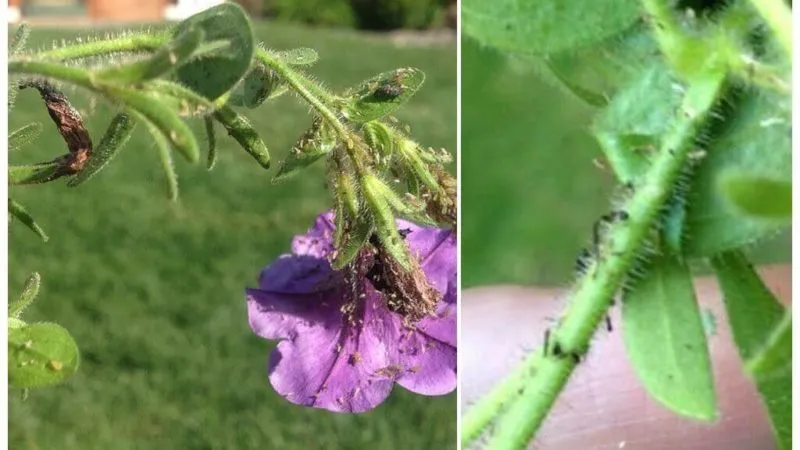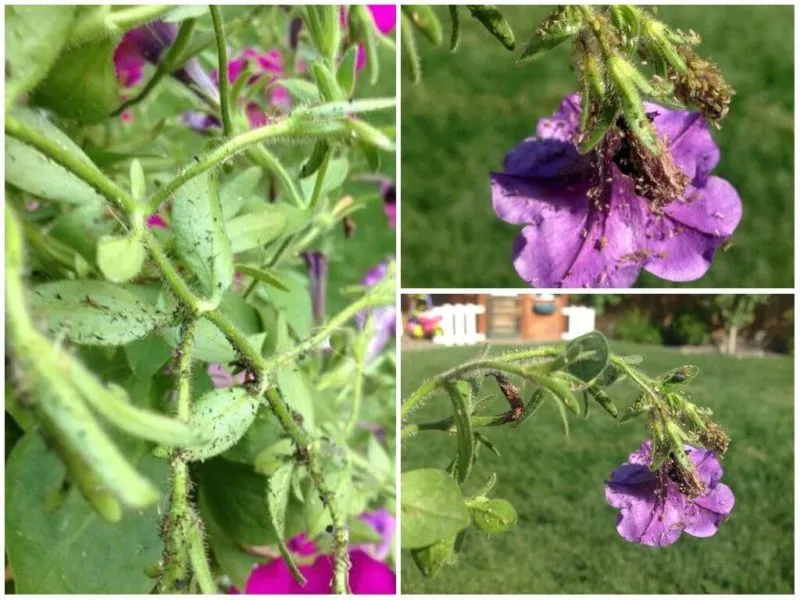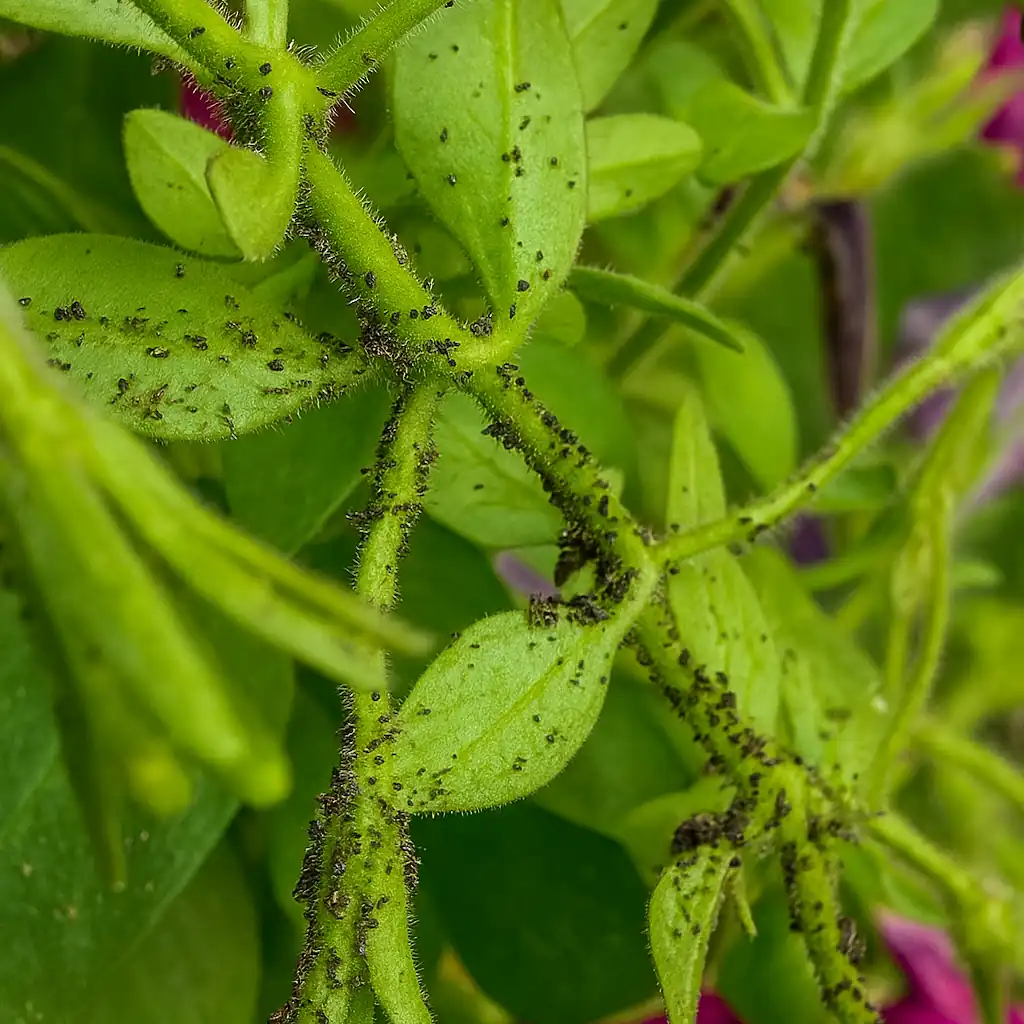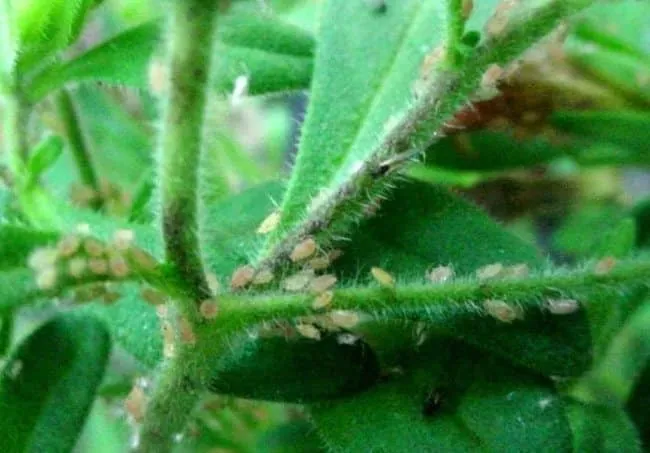Petunias – hardy and low-maintenance plants. They are known for their long blooming period and resilience to cooler temperatures. These flowers grow quickly and, with proper winter care, can thrive for several years. However, diseases and pests can destroy them in less than a month. One of the most dangerous insects for petunias is aphids.
These tiny pests can cause significant damage. Aphids colonize plants rapidly, often leading to their demise. Infestations are frequently accompanied by secondary infections. Saving your flowerbed is possible if you recognize the signs early and take action. Read on to learn how to eliminate aphids from petunias.
Table of contents
What Are Aphids?
Aphids belong to the Hemiptera order and have piercing-sucking mouthparts. They puncture the delicate surface of young leaves and stems to feed on plant sap.
These pests are easily identifiable by their soft, oval or pear-shaped bodies. Despite having long legs, aphids move very slowly.
Most aphids measure between 0.5–2 mm, though some species can reach up to 7 mm.
Their color varies by species. Petunias are commonly attacked by green, gray, or black aphids.
Did you know? Europe is home to over 1,000 aphid species, many of which can infest petunias. Control methods are generally the same regardless of the species.
In spring and early summer, aphids are wingless. By mid-July, some develop wings, allowing them to spread across gardens or greenhouses.
Aphids reproduce rapidly. After mating, a single wingless female can produce up to 150 eggs every two weeks, repeating this cycle up to 20 times.
Aphids colonize petunias in clusters, targeting shoots, leaves, buds, and flowers. Young plants are particularly vulnerable.
Most aphids lay eggs, but some species give birth to live nymphs.
Note. Some aphids are born with wings. Recent studies suggest this occurs when a colony is under threat (e.g., from an abundance of ladybugs). Winged aphids help the population migrate to safer locations.
Why Are Aphids Dangerous?

Aphids rank among the most destructive pests for cultivated plants. They often attack young flowers, damaging their appearance and sometimes killing them.
Key risks of aphids:
- Dehydration. Aphids drain sap from leaves and stems, causing affected parts to dry out.
- Weakened immunity. Nutrient loss and impaired photosynthesis make petunias more susceptible to environmental stress and infections.
- Virus transmission. Aphid saliva often carries plant viruses, which are incurable.
- Fungal growth. Honeydew (sticky excretions) provides an ideal breeding ground for fungi, particularly sooty mold.
- Impaired respiration. Honeydew clogs leaf pores, hindering cellular respiration and causing premature wilting.
Petunias infested with aphids often struggle to survive winter, even indoors. Some aphid species thrive both outdoors and in homes.
Fun fact: Honeydew attracts ants and other omnivorous insects, including locusts, which pose additional threats to plants.
Causes and Spread of Infestation
Understanding aphid reproduction and overwintering helps prevent infestations.
Aphids reproduce throughout warm seasons. In spring and summer, they lay eggs on plant leaves (usually the underside). By autumn, females descend to deposit eggs near the base of plants or in debris, ensuring winter protection under snow.
In spring, nymphs hatch. Most are wingless and rely on ants to transport them onto plants.
Warning! Even a few aphids can quickly multiply. Just 2–3 individuals can lead to a full-blown infestation.
By midsummer, some aphids grow wings, enabling them to spread further. Ants continue to assist in their dispersal.
Common causes of aphid infestations:
- Ant activity
- Uncleared plant debris in autumn
- Infected neighboring plants
Even with preventive measures, aphids may still invade from nearby gardens.
Signs of Aphid Infestation on Petunias


Aphid colonies are visible on young shoots and leaf undersides. The accompanying photo helps with identification.
Additional signs of infestation:
- Stem deformation. Stems develop uneven thickening, become crooked, or droop.
- Stunted growth. Plants stop growing, and flowers or buds drop prematurely.
- Honeydew and shed skins. Sticky residue and white exoskeletons appear on leaves.
- Ant presence. Ants flock to plants to harvest honeydew.
- Discoloration. Leaves pale and lose turgor, eventually drying from the edges inward.
- Chlorosis. Iron deficiency may cause yellowing leaves with prominent green veins.
Methods to Combat Aphids
Eliminating aphids is straightforward, but repairing damage is challenging. Early intervention increases survival chances.
Various control methods exist, each with pros and cons. Gardeners often prefer eco-friendly options over chemicals.
Related reading:
Summer petunia cuttings: A beginner’s guide.
Growing tulips for March 8.
Mechanical Removal
The safest method involves manually removing aphids. Wipe infested areas with a dry or damp cloth, collecting pests on a drop cloth below. Destroy captured insects.
Alternatively, prune heavily infested parts and rinse remaining aphids with a hose.
This method doesn’t guarantee long-term results, as fallen aphids may return.
Biological Control
Introducing natural predators works best for prevention or in large greenhouses. Results take time.
Effective predators:
- Ladybugs
- Lacewings
- Sand wasps
- Spiders
Plant caraway, daisies, tansy, mint, or yarrow to attract beneficial insects. Supplemental feeding or pheromones may help retain them.
Chemical Treatments
Chemical solutions offer fast, lasting results but harm ecosystems. Since petunias aren’t edible, treatments can be applied anytime.
Recommended European products:
- Provado Ultimate Bug Killer
- Bayer Sprayday Greenfly Killer
- Scotts Bug Clear Ultra
- Neudorff BugFree Spray
- Doff All-In-One Pest Spray
These systemic or contact insecticides remain effective for 2–3 days post-application. They’re toxic to most insects.
Note: Repeated use of the same product reduces effectiveness.
Home Remedies
Eco-friendly and safe, these solutions work best for mild infestations.
Popular recipes:
- Soap spray. Dissolve grated dark soap in warm water (1 bar per 10L). Apply during cooler hours.
- Milk and iodine. Mix 2L milk, 30 iodine drops, and 10L water.
- Baking soda. 500g soda in 10L water.
- Coca-Cola. Dilute 1:1 with water.
- Mustard. Soak 100g mustard powder in 10L water for 48 hours.
- Vinegar. 200ml vinegar in 10L water.
- Oil and soap. 500ml vegetable oil + ½ soap bar in 10L water.
Reapply after rain, as home remedies wash off easily.
Treatment Guidelines
Follow these rules for effective pest control:
- Treat plants at least 24 hours before rain. Chemicals last longer than home remedies.
- Wear protective gear when using chemicals.
- Repeat treatments 3 times: chemicals every 2–3 weeks; home remedies weekly.
- Test new solutions on a few stems first.
- Use room-temperature solutions to avoid plant shock.
- Spray in early morning or evening to prevent sunburn.
- Focus on shoot tips and leaf undersides. Treat surrounding soil too.
- Switch products if two applications fail.
Preventive Measures
Prevention is easier than cure:
- Clear garden debris in autumn.
- Treat soil with copper sulfate before planting.
- Weed regularly—aphids often start on weeds.
- Inspect plants weekly for early detection.
- Plant repellents like tansy, marigolds, or garlic nearby.
- Apply preventive insecticides in spring and midsummer.
- Eliminate ant nests—they farm aphids.
Conclusion
Aphids threaten petunias by draining sap, spreading viruses, and promoting fungal growth. Fortunately, they’re manageable with timely action using chemicals, predators, or home remedies. Regular monitoring and preventive care keep these pests at bay.








